The low, open transom of our test boat, a Corsair F-24 trimaran, results in chronically wet sneakers when sailing in rough conditions. At normal speeds, the cockpit stays dry, even off the wind. The stern rises to the approaching waves, and we’re generally surfing away from them anyway, leaving a long, flat wake. But occasionally we slow down because we’re reefing, bumbling a jibe, trolling slowly, or just taking a break, and with only 6 inches of freeboard aft, water washes the length of the cockpit.
In the summer it’s amusing, and we learn not to leave anything on the floor. In winter, however, the water is cold, and unless we are wearing boots or waterproof socks, the rest of the day is less pleasant. In Force 5 conditions it’s just a few inches, and the 8-inch companionway sill is enough to turn water away. In Force 7, we better have a companionway drop board in, or dozens of gallons of water will pour into the cabin in a second.
What we need is a removable board at the transom to keep the waves out. Some people call these duck boards, but that term normally describes planks laid across wet or soft ground. I’ve heard them called splash boards, but that’s more commonly reserved for transom-mounted deflectors on either side of an outboard motor. For our purposes, we’ll call them transom washboards, as distinct from companionway washboards (also known as drop boards).
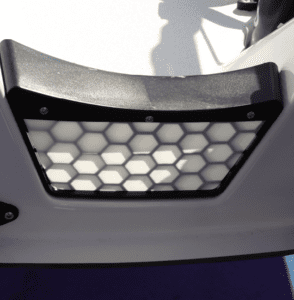
SEAWORTHINESS
Proponents of open-transom designs tell us that these boats are almost never pooped. Perhaps the Dyneema lifelines create a force field that keeps boarding seas at bay? More likely, they have light, broad transoms that obediently rise to every swell. Any serious flooding seems to occur when waves come over the side as the boat yaws. When this happens, the open transom quickly drains. The point is, there is no shortage of open-transom boats that blast through the world’s roughest oceans without much fear of being overwhelmed from astern.
Open transoms have advantages for both cruisers and racers. For racers, they allow a large cockpit that sheds water rapidly. For cruisers they can ease boarding, both from dinghies, floating docks, and from the water. The cockpit is easier to keep clean, and in many cases, becomes effectively self-cleaning. In colder climates, there is a risk that falling leaves or ice might clog the cockpit drains, causing the boat to sink.
The downsides are obvious. In even moderately bad weather, waves can wash into the cockpit, soaking your feet and gear. If the companionway is low and unprotected by wash boards, even a small wave can make the cabin pretty wet. In serious weather, downflooding becomes a serious a concern, unless the companionway boards are very strong.
What about the weight of all that water? At 64 pounds per cubic foot, water sloshing in the cockpit can really upset the fore-aft balance of the boat. The cockpit well of our 24-foot Corsair can hold 1,100 pounds of water, about 1/3 the weight of the boat, or six additional crew members. Meanwhile, an open cockpit will drain in seconds.
We’ve heard of a few cases of sailors being washed out under the lifeline of the cockpit of a race boat. The governing body of international sailing World Sailing stipulates in its rules that there must be two lifelines, with a maximum vertical spacing of 15 inches around the perimeter of the boat, including the stern. A toe rail is required aft of the mast, but the aft end of an open transom cockpit rarely has a one, because that would interfere with draining.
We could, of course, put up a low net (tailgate webbing for pickup trucks) to catch gear and sailors washing aft. Another solution is built-in wash boards that either hinge upward or pull up and lift into place. Sometimes these transom wash boards are the full height of the coaming, but more often they are lower, about seat height.
What about drogues towed from the transom vs. open transoms? We think drogues still make sense for trimarans, because they are the type of boat most susceptible to wave-only capsize. A drogue on a bridle is effective in keeping a trimaran from being caught abeam to a large wave. A large beam-on wave can lift the windward float, rotating the boat and forcing the lee float under. Open cockpits on trimarans are long, but they are narrow, so they don’t hold that much water.
A low transom board, such as we made, will make the cockpit more livable and not trap that much water (see “DIY Transom Washboard”). Don’t like the board there? You can just remove it.
We’d leave the transom splashboard out of a racing monohull; the transom is broad and light, and the boat will rise with the waves. The cockpit can be massive, so it is better to have rapid drainage.
Cruising monohulls are higher, have smaller cockpits and are usually equipped with sturdy OEM transom washboards. As for catamarans, in our limited experience with gales, and from what experienced oceanic cat sailors tell us, significant waves breaking onto the elevated bridge deck are rare. In either case, sailors should insist on sturdy companionway sills and doors.
CONCLUSIONS
A transom washboard can make sailing a little drier and more pleasant in bad weather. Can it make the boat more seaworthy in truly bad weather, or will it make things worse by holding water? The answer is likely boat-specific. One option is to leave the transom open and install strong companionway washboards. If a wave boards from the side or the transom, it will flow out within seconds. Certainly at least one board is smart, and don’t forget to secure it. If you opt for a transom washboard, it needs to meet the World Sailing standard for cockpit volume and drainage rates.
Does your boat have a closed transom? Think about the size of your cockpit drains. Are they clogged, even a little? If they drain below the waterline, odds are there are barnacles in the through-hull and plumbing, and unless you have cleaned them out with a rod this month, they are partially blocked. And what about your companionway washboards? Are they strong enough? Does one of them have a vent or screen? You need a non-vented board to replace it. Many doors are little more than rain protection.
Does a transom washboard make your boat secure against serious wave strike? That depends on cockpit volume and companionway security. A washboard is convenient in moderate weather, but a fast draining cockpit has advantages, too. No doubt, ocean-going boats with open transoms are here to stay, but for the average cruiser, a more traditional design many be more robust.
When it comes to recovering persons in the water, an easy-to-board platform at the stern can be a lifesaver. But what happens when that easy-to-board stern is also slip-and-slide into the sea? Builders of performance cruisers agree that an open transom is a practical route to meeting the racing requirements for shedding water (see page 17). The easy-boarding design is also hit among recreational sailors. But there is little consensus on how to address the open-transom’s Achilles heel—the increased risk of falling overboard.

1. The U.S. Coast Guard Academy’s Leadership 44 sail trainer has an open transom. Liferafts stow in cradles beneath the removable bench seat behind the helm.

2. The broad, open stern of the Beneteau Sense 46 features an easy pathway to the sea, a feature that grows less desirable as you sail away from land.
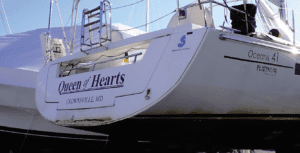
3. This Beneteau Oceanis 41 has a transom washboard that is low enough to allow quick draining, but high enough to keep following seas out during normal sailing conditions.
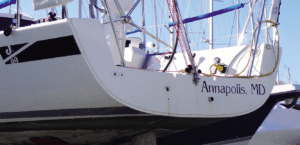
4. This J/99’s open transom almost guarantees a wet cockpit, but that is part of the fun of racing. The key is keeping the water out of the main cabin with tightly sealed companionway hatch and a relatively high companionway sill.

On a breezy summer day we don’t mind wet feet. It’s part of the fun. But in the winter, wet feet are something we avoid.
We investigated a number of locations for installing a transom board on that would keep waves from sloshing aboard our Corsair F-24 test boat. The tiller location and seats that sloped downward and aft near the transom made it impractical to
install washboards at the extreme aft part of the stern.
The spot under the traveler horse was a promising location, but in our case that left the prime helming station unprotected. The best compromise was a 12-inch board just as the seat taper begins, far enough behind the traveler to suit the helmsman, but clear of the tiller.
Ideally the board will be vertical. Sloping forward would encourage a wave to climb it and slosh over. Sloping aft increases impact pressure by trapping the wave and increases lift on the board.
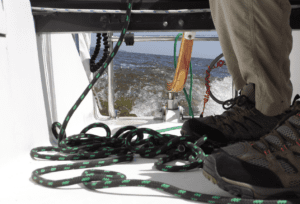
MAKE A TEMPLATE
Foam board from the Dollar Store is a favorite template material. After measuring and cutting (allow for a drainage gap underneath), we taped it in position with duct tape, and went sailing to check for any issues. There were none.
RETAINING CLEATS
Most people will want a removable board, so a pair of vertical retaining cleats on each side provide robust and convenient installation. We used varnished, glycol-borate treated cedar left over from a cockpit sole grating project (see “Products and Tips to Stop Wood Rot,” PS January 2021).
Both the cleats and board should be drilled for some sort of locking pin to prevent the board from lifting out. Alternatively, you can use a shock cord to secure the board in place (“Shock Cord Test Looks at Long Life,” PS March 2022).
MATERIAL
Exterior plywood is a practical choice for the board. We used a floorboard from a discarded inflatable dinghy. Avoid Starboard, it is heavy, weak, and prone to warping.
Use 3/8-inch plywood for a 2-foot span, 1/2-inch for a 3- to 4-foot span, and 3/4-inch for a 6-foot span. Greater spans can be reinforced with cleats on the floor or laminated horizontal beams. Because plywood can get heavy, you may want to consider composites, but these take additional skills and some calculation ability.
Potential core products include Coosa board, foam, or end grain balsa (see “The Multipurpose Core,” PS February 2020). A good laminate schedule would include a layer or two of 1708 biaxial cloth on each side, with one or two layers of 9-ounce unidirectional glass sandwiched between the 1708 on the cockpit side.
If the span is over 4 feet, consider adding some beams for support. You can use carbon, but glass will give the same strength, with a little less stiffness and a little more toughness. For our 24-inch span, ½-inch core with a single layer of 1708 on both sides would have been plenty strong and much lighter than plywood. On the other hand, the extra weight helps hold it in place and the price for plywood was hard to beat (we used a scrap floorboard from an old inflatable dinghy that had reached the end of its life).
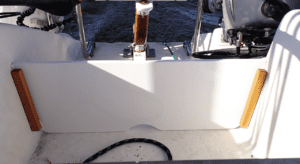
BOTTOM GAP
A small semi-circle in the middle of the splashboard and small triangular openings in each corner allowed for drainage, even when the boat was heeled. We could have installed flaps on the drains, but not enough water enters through the drains to worry about. We’ve found similar flaps on our 420 dinghy need regular maintenance to continue to operate properly.
To avoid drilling holes in the cored deck we attached the cleats with 3M 5200, and about 8 square inches of bond area for each cleat. The sheer strength of 3M 5200 is 400 psi, which is nearly as strong as the skin-to-core bond. If I need to replace the cleats, I can use De-Bond to loosen the grip of 3M 5200 (see “Removing 3M 5200,” PS October 2017).
Another option is a removable transom dock box, like the one found on the J/109. While this is cumbersome to store (you must take it off the boat), it’s easy to make strong and it increases storage volume. It also makes the cockpit smaller, which may be a good thing, and can give the helmsman a place to sit. Just make sure it is tightly secured so that it can’t float away.
Although our new splashboard is removable, we haven’t taken it out yet. It doesn’t get in the way and has the added benefit of keeping dropped hats, gloves and lunch wrappers from blowing out of the cockpit. Perhaps we will pull it out when the weather warms to allow for easier swimming access. This should be easy to do, since the board stores neatly behind a seat in the cabin below, and drops effortlessly into the slot when we need it.

The ideal companionway hatch and sill design depends on the boat. We truly dislike sliding doors on boats, but a large catamaran restricted to coastal waters can get by with one. The deck is high off the water, the cockpit is covered by a massive hardtop, and there isn’t enough heel to turn a sliding door into a deadly weapon so long as it is locked.
At the other extreme is a sporty keel boat with a low cockpit and an open transom, which can fill even in coastal waters. In the case of the sport boat, it’s easy to slide in a drop board if the weather gets violent.
Drop boards must be restrained so they cannot fall out in a knockdown or rollover. Likewise, when they are removed, the must be stowed securely in a place where they are easily accessible. Some padeyes and a shock cord are usually enough to keep them in place.
Our view is that any sill lower than 6 inches is worthless. For offshore sailing, our reviewers generally look for permanent sills that are at least 12 inches above the cockpit sole.
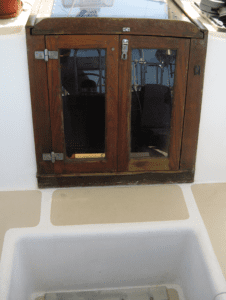
1. French-style doors with glazing panels should be rated high strength and well-reinforced.
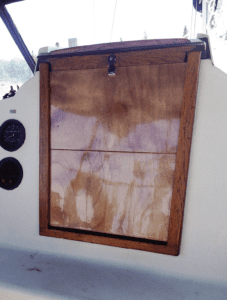
2. Drop boards should be tight fitting, secured in place, and without any holes or vents.
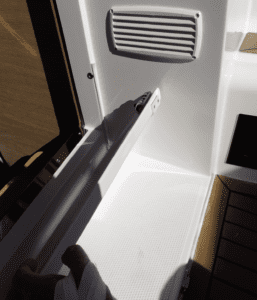
3. Beneteau’s hinged sill substitutes for a permanent sill. We prefer a permanent sill, but this is better than a drop board.
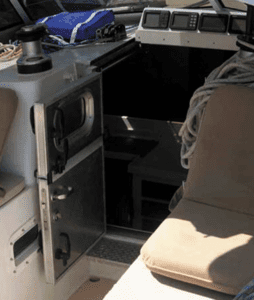
4. The rugged companionway door on the Van de Stadt 47 that Beth and Evans Starzinger sailed around the world was built by the Canadian company Diamond/Sea-Glaze (see “Bulletproof Companionways,” Mailport PS October 2015).



































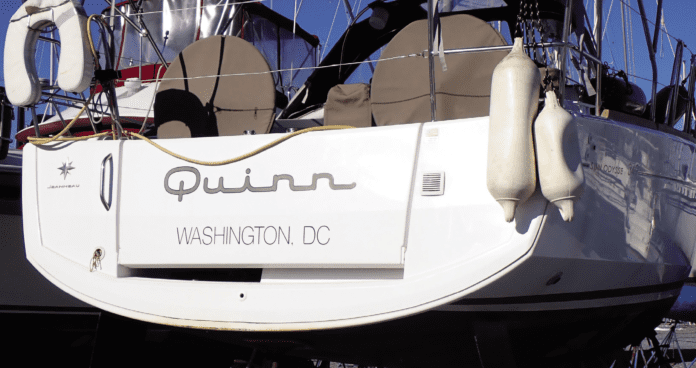





Good article. Sensible solutions. I personally don’t care for the open transom. Three offshore round trip voyages to the Virgin Islands from NC. No horrible conditions but some big seas occasionally. Never pooped. But with an open transom?–maybe.
But another thing not often mentioned is while an open transom can make getting off and on a dinghy easier it also makes it easier for unwanted visitors to get on the boat. Over the years I have read and talked to a couple people who have had intruders that swam out to their boats and climbed aboard over open transoms. It’s not a big thing in the scheme of life but something to be aware of.
Open transom can also make installing a self steering windvane problematic. Choices. Compromises.